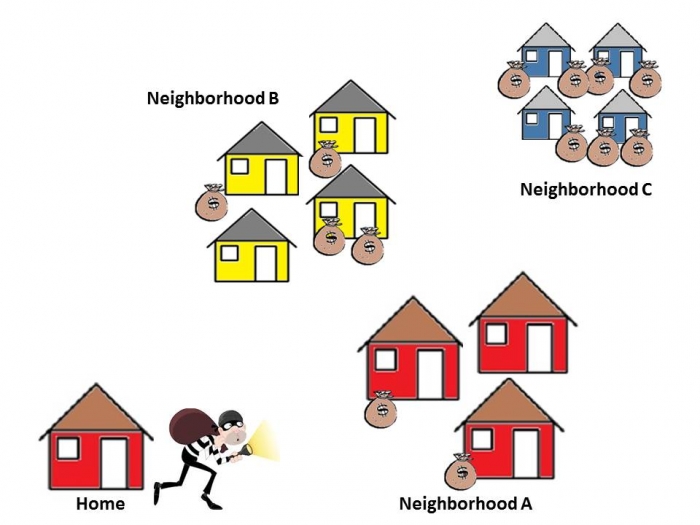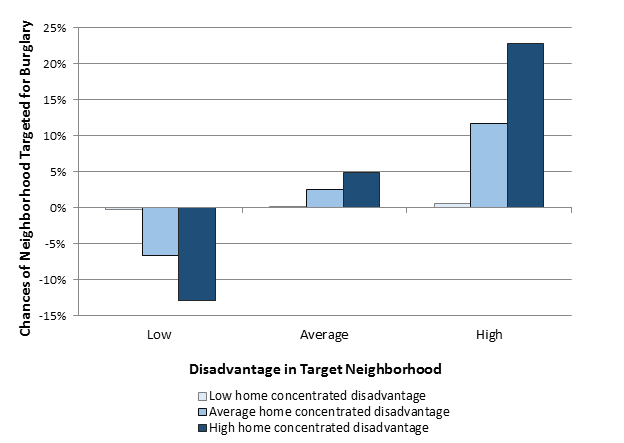
 Despite concerns about crime among the wealthy and middle-class, crime is much more prevalent in poor inner-city neighborhoods than in better off suburbs. In new research, Alyssa W. Chamberlain and Lyndsay N. Boggess explore why wealthier neighborhoods have lower burglary rates – after all, they are more likely to possess more valuable goods. They find that burglars from poorer areas are more likely to target neighborhoods more disadvantaged than their own. They write that not only are wealthier neighborhoods more likely to be further away, increasing the risks for potential burglars; they are also likely to be more socially connected. More disadvantaged neighborhoods, on the other hand, are more likely to be less socially cohesive, making it easier for burglars to remain anonymous.
Despite concerns about crime among the wealthy and middle-class, crime is much more prevalent in poor inner-city neighborhoods than in better off suburbs. In new research, Alyssa W. Chamberlain and Lyndsay N. Boggess explore why wealthier neighborhoods have lower burglary rates – after all, they are more likely to possess more valuable goods. They find that burglars from poorer areas are more likely to target neighborhoods more disadvantaged than their own. They write that not only are wealthier neighborhoods more likely to be further away, increasing the risks for potential burglars; they are also likely to be more socially connected. More disadvantaged neighborhoods, on the other hand, are more likely to be less socially cohesive, making it easier for burglars to remain anonymous.
It’s a fact that crime in the United States is concentrated in impoverished urban areas. Although one often immediately thinks of the high rates of violence in most inner cities, property crimes like burglary and theft are also more prevalent in poor inner-city neighborhoods than their suburban counterparts. One reason may be that residents of disadvantaged neighborhoods engage in property crime to obtain material goods that they are unable to afford or otherwise attain through legal means. This suggests that the acquisition of valuable goods is a primary motivator of burglary, and that would-be offenders should be more likely to target wealthy neighborhoods, where the supply of valuable goods is greater. Why, then, don’t wealthier neighborhoods have higher rates of burglary?
Burglars are calculating and risk averse. As such, the possibility of more lucrative targets in affluent neighborhoods may be offset by the relative risk associated with their acquisition. Indeed, there are a number of factors that discourage offending in well-off neighborhoods. First, economic segregation means that affluent neighborhoods may be further away. Since traveling to different areas entails greater risks and increased effort, most potential offenders commit crimes close to home to minimize both. Additionally, this relies on the offender knowing about more valuable targets in affluent neighborhoods. However, potential burglars are most aware of opportunities in the nearby and similarly disadvantaged areas (where most burglars reside) because that’s where their daily life occurs rather than the physically distant wealthier neighborhoods.
Second, residents in well-off neighborhoods tend to be more socially connected, which facilitates the ability to collectively address problems such as crime or be on the lookout for someone who does not belong. Indeed, robbers have admitted that they avoid targeting areas where watchful residents might intervene. In contrast, the poverty, racial and ethnic diversity, and residential instability that typify disadvantaged neighborhoods reduce social cohesion and weaken residents’ ability to prevent criminal offending.
Third, burglars may be more likely to select a neighborhood based on its racial/ethnic composition to further minimize the risk of detection. Most affluent neighborhoods tend to be relatively homogenous and largely white, while the disadvantaged neighborhoods where most offenders reside are largely comprised of racial/ethnic minorities. Offenders may be less willing to burgle in racially different neighborhoods because the different and unfamiliar social and cultural norms associated with well-off neighborhoods may make the offender more conspicuous. At the same time, ethnically diverse neighborhoods may be attractive targets because the lack of an overarching social identity provides anonymity for burglars unfamiliar with these norms.
Importantly, the degree to which a target is considered attractive is subjective. One factor that may affect how a burglar perceives a target is the offender’s home neighborhood. In fact, target attractiveness is likely colored by the characteristics of the target neighborhood relative to the offender’s home neighborhood. Since many offenders reside in disadvantaged areas, the perception of affluence may be a matter of scale: an offender chooses a more affluent neighborhood relative to his or her own, but one which is still considered a disadvantaged neighborhood within the city. Alternatively, disadvantaged neighborhoods may be more desirable targets because the risk of getting caught is lower which may outweigh potential financial gains associated with burgling in wealthier neighborhoods. Indeed, some potential burglars seek out neighborhoods that are more disadvantaged than their own.
Taken together, target selection necessitates finding the optimal balance between risk and reward. Our research uncovers how the characteristics of an offender’s home neighborhood relative to each potential target neighborhood (i.e., all other neighborhoods in the city) affect target selection above and beyond geographic proximity to the offenders’ residence. To do this, we collected information on all burglary arrests in the city of Tampa, Florida between January 2000 and September 2012. The data contain suspects’ home and target addresses, which we mapped and linked to US Census socioeconomic and demographic data for neighborhoods.
Would-be offenders can theoretically choose any neighborhood within the city to target; therefore, we utilized a special statistical model that can examine what neighborhood factors might explain individual decisions on where to burgle. To illustrate the decision process we’re investigating, Figure 1 below depicts a potential burglar contemplating which neighborhood would yield the most rewards while minimizing the risk of apprehension. While assessing these dynamics, a suspect considers the distance of the target and the similarities to his home neighborhood. In this example, Neighborhood A has fewer risks because it is the most similar to the burglar’s home, but it’s likely the least lucrative, while Neighborhood C may be the most profitable, but has a higher risk of getting caught given the dissimilarities to the burglar’s home.
Figure 1 – Burglar Decision-Making Process

We find that burglars tend to target neighborhoods that have greater racial/ethnic diversity, have a larger Black population, and more disadvantage; and these neighborhoods are similar to the burglars’ home neighborhoods. That is, burglars are less likely to select neighborhoods that have different, racial/ethnic composition, racial/ethnic diversity, or disadvantage. This suggests that suspects are attracted to targets in neighborhoods that look like their home neighborhood, regardless of distance.
However, while most burglars preference neighborhoods that are similar to theirs, some burglars deviate from this pattern and select targets that are dissimilar to their home neighborhood. To determine how a potential burglar discriminates between neighborhoods relative to his or her own neighborhood, we also examined the directionality of these differences. We find that when burglars target dissimilar neighborhoods, they select neighborhoods that are more vulnerable than their home neighborhood. For instance, burglars are more likely to target ethnically diverse neighborhoods relative to their own, as the lower levels of social cohesion characteristic of those neighborhoods reduces the risk of apprehension.
Burglars are also more likely to target neighborhoods that have higher levels of disadvantage relative to the disadvantage in their home neighborhood. In Figure 2 below we graph the relationship between disadvantage in a burglar’s home neighborhood (shaded blue columns) and target neighborhood (the x-axis). Burglars seek out areas with more disadvantage than their home neighborhood. For instance, the odds that a burglar from a neighborhood with average disadvantage selects a target in a highly disadvantaged neighborhood are far greater than his odds of targeting a similar or lower disadvantaged neighborhood. Further, Figure 2 shows that it is unlikely that a suspect from any neighborhood selects a target neighborhood with lower disadvantage, suggesting that the prospect of more valuable targets does not lure burglars into wealthier neighborhoods.
Figure 2 – Effect of concentrated disadvantage in target neighborhood on likelihood of burglary, moderated by level of concentrated disadvantage in home neighborhood.

These findings help explain why property crimes concentrate in impoverished (and inner city) neighborhoods as opposed to wealthy neighborhoods. The characteristics of disadvantaged neighborhoods – poverty, ethnic diversity, residential instability – may make these neighborhoods more attractive because the likelihood of success is greater even if the targets are not as lucrative. Since disadvantaged neighborhoods are typically clustered in a city, these same neighborhoods might be burglary hot spots. With a national clearance rate for burglary just over 13 percent in 2014, examining the broader social and economic context of burglary locations may help law enforcement to deploy resources more effectively.
This article is based on the paper, ‘Relative Difference and Burglary Location’, in the Journal of Research in Crime & Delinquency.
Featured image credit: Daniel Hoherd (Flickr, CC-BY-NC-2.0)
Please read our comments policy before commenting.
Note: This article gives the views of the author, and not the position of USAPP – American Politics and Policy, nor the London School of Economics.
Shortened URL for this post: http://bit.ly/2dtwZJh
_________________________________
 Alyssa W. Chamberlain – Arizona State University
Alyssa W. Chamberlain – Arizona State University
Alyssa W. Chamberlain is an Assistant Professor in the School of Criminology and Criminal Justice at Arizona State University. Her research examines neighborhood dynamics related to changes in social and demographic structure, housing, and inequality and the spatial distribution of crime. She also examines issues related to prisoner reentry and corrections, including offender supervision, and neighborhood reintegration.
 Lyndsay N. Boggess – University of South Florida
Lyndsay N. Boggess – University of South Florida
Lyndsay N. Boggess is an Associate Professor in the Department of Criminology at the University of South Florida. Her research focuses on the community correlates of crime, with particular interest in how neighborhoods change over time, the housing market and gentrification, and racial/ethnic composition and immigration.






